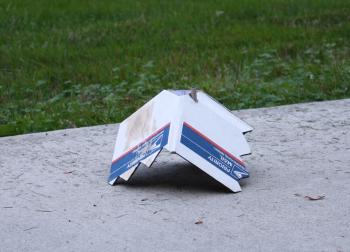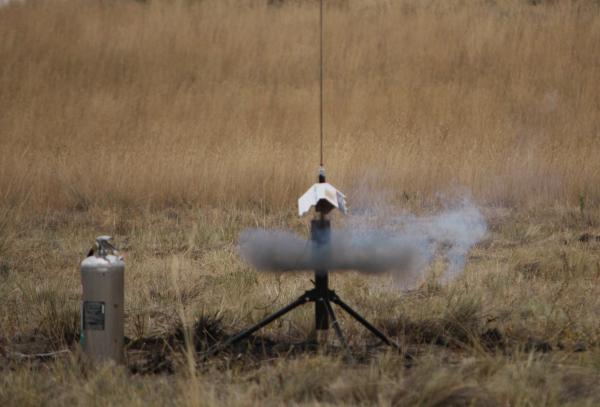Art Applewhite Rockets Priority Stealth 29mm Plan
Art Applewhite Rockets - Priority Stealth 29mm {Plan}
Contributed by William Carpenter
| Construction Rating: | starstarstarstarstar |
| Flight Rating: | starstarstarstarstar |
| Overall Rating: | starstarstarstarstar |
| Manufacturer: | Art Applewhite Rockets  |
| Style: | Pyramid |
 Brief:
Brief:
The Priority Stealth is a mid-power rocket from Art Applewhite Rockets that flies on 29mm motors. As the name implies, it is a version of Art's Stealth design, which has versions from 13mm all the way up to 54mm. What makes the Priority Stealth unique is the fact that it is made from a 7"x7"x6" Priority Mail box (hence the name) or any other thick, corrugated cardboard box.
Modifications:
Construction:
The only required components are...
- A Source of Cardboard (preferably a 7"x7"x6" Priority Mail box)
- Templates Available on the Art Applewhite Site
- A Roll of Clear Packing Tape (may not be needed on some boxes)
- You will also need some glue (the instructions specify white glue) and a hobby knife.
The construction of the Priority Stealth is quite simple, and it is made even easier by Art's detailed instructions. The instructions can be either used digitally right of the webiste, or can be printed. They include full color photos for each step of construction.
I used a 5"x5"x6" Priority Mail box.
Construction starts by flattening the box and then slicing it up as per the instructions. The templates are then used to mark the three faces of the rocket, the motor mount tube, and the bottom of the rocket. The parts are then cut out with a hobby knife.
The three faces are then formed and glued into the tetrahedral shape of the Stealth and allowed to dry.
The bottom of the rocket is then glued into the three faces.
The triangular MMT is then formed from a piece of cardboard and then glued into the rest of the rocket.
All of the rocket's joints then get glue fillets. I used white glue in my construction as per the instructions, but if I build another one I'll probably use something a little stronger.
After testing it's fit on a launch rod, I ended up taking a launch lug left over from a kit that I added rail buttons to and gluing it inside the launch rod holes in the Stealth. I did this after the test showed that there was a lot of friction between the rod and the Stealth.
Finishing:
Finishing on this rocket is completely optional. Thinking that it would be difficult to finish corrugated cardboard, I decided to leave it looking... well... postal. The instructions recommend a coat of two of clear coat to protect the cardboard from moisture. I elected not to do this and just not be able to launch this rocket on wet ground.
Construction Rating: 5 out of 5
Flight:
Art Applewhite recommends any 29mm rocket motor with an average thrust of 20-80 newtons and a burnout weight of 85 grams or less. The weight criteria means that all of the 29mm mid-power Aerotech casings will do, assuming that there is a reload compatible with the Stealth. I do, however, feel that anything even near 80 newtons of thrust would be overkill, and I wouldn't trust it in a rocket made from a cardboard box.

The first flight of my Priority Stealth was at the Washington Aerospace Club's then un-named September launch. The Stealth was loaded with an Aerotech F22, selected for it's long, 3.5 second burn. The motor was assembled without the ejection charge. The BP well was filled with grease, and I put on the red cap out of force of habit.
The Stealth moved surprisingly fast for an oddroc. It climbed straight and true to what looked like 300' - 400'. It had generated a pretty rapid spin by the time it reached Apogee.
The Stealth flew two more times on F22s at this launch. A video of one of those flights can be seen here.
Recovery:
Like all Art Applewhite rockets, the Priority Stealth uses aerobrake recovery. Even in brisk wind on the first flight, it landed only 30' or so from the pad. I was at first worried about damage to my casing on landing, but the shape of the Stealth makes it so that it lands squarely on the ejection charge cap on the top of Aerotech loads. The casing also gets pushed back into the rocket on landing.
Flight Rating: 5 out of 5
Summary:
Considering the price, the Priority Stealth is a great performer. Most free rockets end in the low-power range, so the Stealth stands out in that it is a true mid-power rocket. While it's structural limitations limit it to a small selection of motors, it will perform admirably on the motors it can stand up to.
The thing I love most about free rockets is that if you lose/shred/otherwise render it inoperable, just print out the templates and make another one.
The plans to build your own Priority Stealth can be found at this URL.
Overall Rating: 5 out of 5
Sponsored Ads
 |
 |











